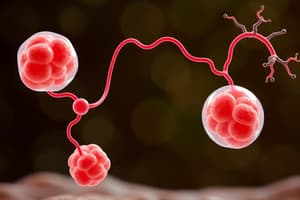Podcast
Questions and Answers
What is the most important regulator of glycolysis?
What is the most important regulator of glycolysis?
- Acetyl CoA
- Pyruvate kinase
- Lactate dehydrogenase
- Phosphofructokinase (correct)
How many ATP molecules are produced from glycolysis in red blood cells?
How many ATP molecules are produced from glycolysis in red blood cells?
- 4 ATP
- 6 ATP
- 2 ATP (correct)
- 1 ATP
What molecule do two pyruvate molecules get converted into during oxidative decarboxylation?
What molecule do two pyruvate molecules get converted into during oxidative decarboxylation?
- Acetyl CoA (correct)
- NADH
- Lactate
- Citrate
What is the energy yield from the oxidation of one molecule of NADH?
What is the energy yield from the oxidation of one molecule of NADH?
What is the primary function of glycolysis?
What is the primary function of glycolysis?
What is the primary function of the citric acid cycle?
What is the primary function of the citric acid cycle?
Where does glycolysis take place within the cell?
Where does glycolysis take place within the cell?
How much ATP is produced from the oxidation of two molecules of acetyl CoA in the citric acid cycle?
How much ATP is produced from the oxidation of two molecules of acetyl CoA in the citric acid cycle?
Which of the following enzymes is involved in the first step of glycolysis?
Which of the following enzymes is involved in the first step of glycolysis?
Which component is primarily responsible for the anabolic functions within the citric acid cycle?
Which component is primarily responsible for the anabolic functions within the citric acid cycle?
Which organ is primarily dependent on glycolysis for energy due to the lack of mitochondria?
Which organ is primarily dependent on glycolysis for energy due to the lack of mitochondria?
Which of the following is NOT a product of the citric acid cycle?
Which of the following is NOT a product of the citric acid cycle?
What occurs during the first phase of glycolysis?
What occurs during the first phase of glycolysis?
What is the main product of glycolysis under aerobic conditions?
What is the main product of glycolysis under aerobic conditions?
Which of the following statements about the citric acid cycle (Krebs cycle) is true?
Which of the following statements about the citric acid cycle (Krebs cycle) is true?
Which pathway for glucose oxidation does NOT produce energy?
Which pathway for glucose oxidation does NOT produce energy?
Flashcards are hidden until you start studying
Study Notes
Glycolysis
- Definition: The breakdown of glucose to pyruvate or lactate.
- Site: Cytoplasm of every cell.
- Key Enzymes:
- Glucokinase (liver) and Hexokinase (other tissues)
- Phosphofructokinase (rate limiting step)
- Pyruvate kinase
- Medical Importance:
- Essential for energy production in all cells.
- Particularly important in red blood cells, skeletal muscles during exercise, testes, and leukocytes.
Hormonal Regulation of Glycolysis
- Insulin: Stimulates glycolysis by enhancing the activity of key enzymes like hexokinase and phosphofructokinase.
- Glucagon: Inhibits glycolysis by reducing the activity of key enzymes.
Oxidative Decarboxylation of Pyruvate
- Definition: The conversion of pyruvate to acetyl CoA.
- Site: Mitochondria
- Key Enzyme: Pyruvate Dehydrogenase Complex (PDH)
- Products: Acetyl CoA, NADH
Citric Acid Cycle (Krebs Cycle)
- Definition: A series of reactions that oxidize acetyl CoA to CO2, water, and energy.
- Site: Mitochondria
- State: Aerobic (presence of oxygen)
- Key Steps:
- Acetyl CoA condenses with oxaloacetate to form citrate.
- Citrate is converts back to oxaloacetate at the end of the cycle.
- Energy Yield:
- One acetyl CoA produces 10 ATP.
- Two acetyl CoA produce 20 ATP.
Biomedical Importance of the Citric Acid Cycle
- Amphibolic: Has both anabolic and catabolic functions.
- Anabolic Functions:
- Synthesis of fatty acids (from citrate)
- Synthesis of ketone bodies and cholesterol (from acetyl CoA)
- Synthesis of glucose (gluconeogenesis)
- Synthesis of non-essential amino acids:
- Pyruvate → alanine
- Oxaloacetate → aspartate
- α-ketoglutarate → glutamate
- Synthesis of heme (from succinyl CoA and glycine)
Studying That Suits You
Use AI to generate personalized quizzes and flashcards to suit your learning preferences.




